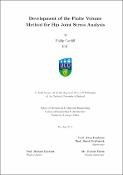Options
Development of the Finite Volume Method for Hip Joint Stress Analysis
Author(s)
Date Issued
2012-10
Date Available
2016-09-13T16:56:55Z
Abstract
Total Hip Arthroplasty is a surgical procedure that reforms the hip joint, replacing the pathological joint with an artificial prosthesis. Due to post-operative joint instability, complications such as dislocation are still a significant problem. Understanding the mechanics of the hip joint is key in the development of preventative methods to treat post-operative hip dislocation. The principal aim of this thesis is to develop a numerical model of the hip joint capable of realistically capturing musculoskeletal loading and joint mechanics. A finite volume structural solver, implemented in open-source software OpenFOAM, has been developed, which is capable of accurately predicting large displacements, large rotations and small strains. A contact procedure, based on an iterative penalty method, has been established and verified against the available Hertzian analytical solution. In order to accurately represent the musculotendon loading, Hill-type muscle models have been developed, and a novel mapped muscle attachment approach capable of accurately capturing the muscle fibre force directions has been implemented. A procedure for extracting the hip joint geometry from computed tomography and magnetic resonance imaging scans has been developed. A technique has been established to accurately extract the muscle-bone attachment sites from the tomographic images. Volumetric meshes of the bones have been constructed using hexahedral, tetrahedral, polyhedral and voxel based meshes and a comprehensive 3-D mesh analysis study has been conducted. Gait analysis has been performed on the same subject from which the tomography images were obtained, and custom analysis utilities have been developed to allow processing and visualisation of the data. Furthermore, a method has been established to process the obtained electromyography signals into a form suitable for input into the developed Hill-type muscle models. The hip joint has been simulated for three separate phases of the gait cycle. The relative positioning of the femur and pelvis bones has been determined from gait analysis, and the applied total hip joint forces have been established from literature. Each of the investigated models has been simulated with and without muscular loading, and the effect of muscle attachment approach has been investigated. The predicted average contact pressures and contact areas ranged from 5.93 to 10.1 MPa and 3.83 × 10-4 to 4.62 × 10-4 m2 respectively. Maximum von Mises stresses in the cortical bone ranged from 30 to 50 MPa and occurred in the acetabular roof, the body of the ilium superior to the acetabulum, near the iliosacral joint, the neck of the femur and the body of the femur. It has been found that the inclusion of musculotendon forces significantly
External Notes
A hard copy of this thesis is available in UCD Library, thesis 12034
Type of Material
Doctoral Thesis
Qualification Name
Ph.D.
Publisher
University College Dublin. School of Mechanical & Materials Engineering.
Language
English
Status of Item
Peer reviewed
This item is made available under a Creative Commons License
File(s)
Loading...
Name
CardiffFinalPhdThesis.pdf
Size
35.35 MB
Format
Adobe PDF
Checksum (MD5)
9b75eac880ab2e917e49e30b8fa9836e
Owning collection